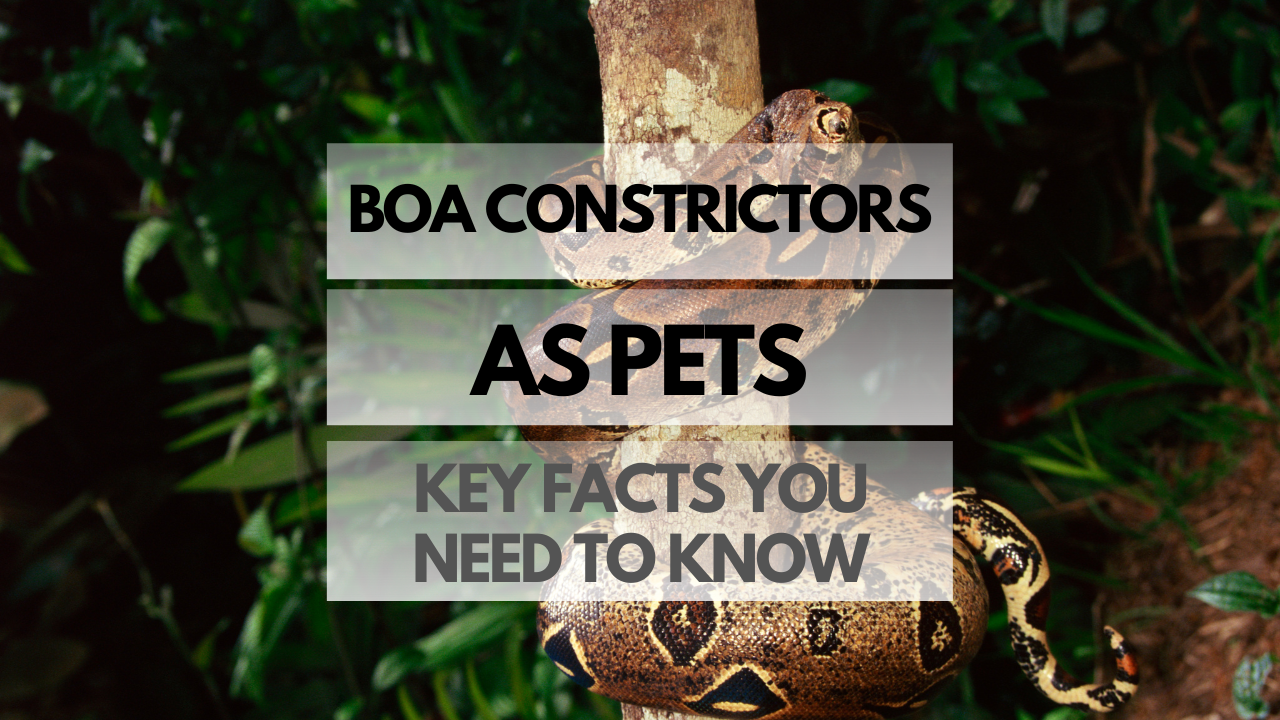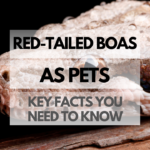Boa constrictors are fascinating creatures with a rich history that dates back to ancient civilizations. These large, non-venomous snakes have become increasingly popular pets due to their unique appearance, gentle temperament, and relatively low maintenance requirements. In this article, we’ll explore everything you need to know about keeping boa constrictors as pets, from the basics to detailed care tips.
Quick Reference Table: Boa Constrictor Facts
| Fact | Details |
|---|---|
| Average Lifespan | 20-30 years in captivity |
| Size | 5-13 feet, depending on species |
| Diet | Obligate carnivore, primarily rodents |
| Temperament | Docile, typically handleable with proper socialization |
| Native Habitat | Central and South America |
| Conservation Status | Varies by species, some threatened by habitat loss and over-collection |
How Are Boa Constrictors as Pets?
Boa constrictors can make excellent pets for the right owner. They are typically docile and can become accustomed to handling with proper socialization. However, their large size and long lifespan make them suitable only for those who are committed to providing a lifetime of care.
Pros and Cons of Boa Constrictors
Pros:
- Generally docile and tolerant of handling
- Low-maintenance feeding schedule
- No venom
Cons:
- Large size requires a spacious enclosure
- Long lifespan necessitates long-term commitment
- Not suitable for households with small children or pets
Boa Constrictor Behavior and Temperament
Boa constrictors are known for their calm and easygoing temperament. They are typically not aggressive, although they may strike if they feel threatened or mistake a hand for food. Regular handling can help them become comfortable with their human caretakers and reduce the risk of defensive behavior.
How Much Do Boa Constrictors Cost?
The cost of a boa constrictor can vary depending on the species, size, and coloration. Prices can range from $50 for a common boa to several thousand dollars for a rare or highly sought-after morph. In addition to the snake itself, you’ll need to consider the initial setup costs for the enclosure and equipment, as well as ongoing expenses for food, substrate, and electricity for heating and lighting.
Boa Constrictor Lifespan: Time and Commitment
Boa constrictors have an average lifespan of 20-30 years in captivity. This long life expectancy means that owning a boa constrictor is a significant commitment. In addition to providing proper care and housing, owners should be prepared to invest time in regular handling and socialization to ensure their snake remains comfortable and well-adjusted.
Boa Constrictor Size
Boa constrictors are large snakes, with adult sizes ranging from 5 to 13 feet depending on the species. Males are typically smaller than females. When selecting an enclosure, it’s essential to choose one that will comfortably accommodate your boa’s full adult size.
Boa Constrictor Species
There are several species and subspecies of boa constrictors, each with its own unique characteristics and care requirements. Some of the most popular species in the pet trade include:
Common Boa Constrictor (Boa constrictor imperator)
Common boa constrictors are native to Central and South America and are the most frequently kept species in captivity. They are known for their docile temperament and beautiful patterns, which can vary widely among individuals. Adult sizes range from 5 to 9 feet, making them more manageable for many pet owners than the larger true red-tailed boa.
True Red-Tailed Boa (Boa constrictor constrictor)
True red-tailed boas are native to South America and are highly sought after for their striking coloration, which includes a deep red tail. They tend to be larger than common boas, with adult sizes ranging from 7 to 13 feet. They have a similar temperament to common boas but may require more space and experience to care for due to their size.
Boa Constrictor Colors, Looks and Appearances
Boa constrictors come in a wide variety of colors and patterns, thanks to both natural variation and selective breeding. Some common color morphs include albino, anerythristic, pastel, and jungle, among others. In addition to their diverse coloration, boa constrictors are known for their muscular bodies, distinctive patterns, and smooth, iridescent scales.
Boa Constrictor Care Guide
Proper care is essential to ensure your boa constrictor remains healthy and happy throughout its long life. This includes providing suitable housing, maintaining appropriate environmental conditions, and offering a balanced diet.
Boa Constrictor Habitat: Tank and Housing
Creating a comfortable and secure habitat is essential for your boa constrictor’s health and well-being. This includes selecting the right enclosure, maintaining proper environmental conditions, and providing appropriate furnishings and decorations.
Appropriate Boa Constrictor Tank Size
A boa constrictor’s enclosure should be large enough to allow the snake to stretch out its entire length and move around comfortably. A general guideline is to provide an enclosure with a length and width that, when combined, equal or exceed the snake’s length. For example, a 6-foot-long boa would need an enclosure that is at least 3 feet by 3 feet.
Types of Enclosures
There are several types of enclosures suitable for boa constrictors, including glass terrariums, plastic tubs, and custom-built cages. The best choice will depend on your specific needs and preferences, but all options should provide adequate ventilation and security to prevent escapes.
Substrate Options
Various substrates can be used for boa constrictors, including newspaper, aspen shavings, cypress mulch, and coconut husk. The substrate should be absorbent, easy to clean, and non-toxic. Avoid using cedar or pine shavings, as they can cause respiratory issues in snakes.
Heating and Lighting Requirements
Boa constrictors are ectothermic, meaning they rely on their environment to regulate their body temperature. Provide a temperature gradient in the enclosure, with a warm basking area of 88-92°F and a cooler area of 75-80°F. Use heat lamps, under-tank heaters, or heat tape to achieve the desired temperature range. While boa constrictors do not have specific UVB requirements, providing a regular day/night cycle with natural or artificial lighting is important for their overall well-being.
Humidity and Temperature Control
Maintain a humidity level of 50-70% in the enclosure, with slightly higher levels during shedding. Use a hygrometer to monitor humidity and mist the enclosure as needed to maintain proper levels. Avoid letting the humidity become too high, as this can lead to respiratory issues.
Furnishings and Decorations
Provide your boa constrictor with hiding spots, such as hide boxes or hollow logs, where it can feel secure. Include sturdy branches or shelves for climbing, as this can help promote natural behaviors and exercise. Live or artificial plants can also be added to create a more naturalistic environment.
Cleaning and Maintenance
Regular cleaning is essential to maintain a healthy environment for your boa constrictor. Spot clean the enclosure daily by removing any waste, and perform a full cleaning with disinfection every 4-6 weeks. Replace the substrate as needed, depending on the type you are using.
Boa Constrictor Food: Diet and Nutrition
Boa constrictors are obligate carnivores, meaning they require a diet of whole prey items, such as rodents. Providing a balanced diet is crucial for your snake’s health and growth.
Feeding Frequency and Schedule
Boa constrictors have a low-maintenance feeding schedule. Juveniles should be fed every 7-10 days, while adults can be fed every 2-4 weeks, depending on their size and activity level. Adjust the feeding frequency as needed to maintain a healthy body weight for your snake.
What do Boa Constrictors Eat?
Boa constrictors primarily eat whole prey items, such as rodents. Depending on the size of your snake, appropriate food options may include mice, rats, or even small rabbits. It is recommended to feed pre-killed or frozen-thawed prey to reduce the risk of injury to your snake.
Boa Constrictor Treats
While boa constrictors do not typically require treats like many other pets, you can occasionally offer a different type of prey item as a form of enrichment. For example, you might alternate between mice and rats or provide a quail or small chicken as a treat. Be cautious not to overfeed or offer prey items that are too large for your snake, as this can lead to health issues.
Foods to Avoid
Boa constrictors should not be fed any food items that are not part of their natural diet, such as fruits, vegetables, or processed pet foods. Stick to whole prey items, specifically rodents, to ensure your snake receives the proper nutrition it needs to thrive.
Supplements and Vitamins
Boa constrictors generally do not require vitamin or mineral supplements when fed a diet of whole prey items, as these provide all the necessary nutrients. If you have concerns about your snake’s diet or overall health, consult with a reptile veterinarian for guidance on any additional supplementation that may be required.
Hydration
Boa constrictors need access to fresh water at all times. Provide a large water dish in the enclosure that is big enough for your snake to soak in but not too deep that it poses a drowning risk. Make sure to change the water regularly and clean the dish to prevent the growth of bacteria and other harmful organisms.
Handling and Socialization
Taming and Bonding
Boa constrictors can become accustomed to handling with patience and consistency. Start by handling your snake for short periods, gradually increasing the duration over time. Regular handling will help build trust and strengthen the bond between you and your boa constrictor.
Safe Handling Techniques
When handling a boa constrictor, always support its body and avoid sudden movements. Approach your snake calmly and confidently, using a snake hook if necessary. Be mindful of your snake’s body language and give it space if it shows signs of stress or discomfort.
Signs of Stress and Illness
Boa constrictors may display stress through behaviors such as hissing, striking, or attempting to escape. Signs of illness may include lethargy, weight loss, lack of appetite, or difficulty breathing. If you notice these signs, consult a reptile veterinarian for further guidance.
Introducing Boa Constrictors to Other Pets
Boa constrictors are solitary animals and should not be housed with other snakes or pets. Introducing your boa constrictor to other pets may cause unnecessary stress and could result in injury or illness. It’s best to keep your boa constrictor in a separate enclosure and supervise any interactions with other pets.
Health and Wellness
Common Health Issues
Boa constrictors can suffer from various health issues, including respiratory infections, mites, scale rot, and improper shedding. Maintaining a clean enclosure and monitoring your snake’s behavior can help prevent these issues.
Signs of a Healthy Boa Constrictor
A healthy boa constrictor will have clear eyes, a clean nose and mouth, and a smooth, shiny skin. It should be alert, active, and have a strong appetite. Regularly monitor your snake’s health and consult a reptile veterinarian if you have any concerns.
Preventative Care
Preventative care for boa constrictors includes maintaining proper temperature and humidity in the enclosure, providing a clean environment, and feeding a balanced diet. Regular health check-ups with a reptile veterinarian can help detect and address any issues early on.
Finding a Reptile Veterinarian
It’s essential to find a qualified reptile veterinarian to care for your boa constrictor. Ask for recommendations from fellow snake owners, local reptile clubs, or pet stores that specialize in reptiles. Ensure the veterinarian has experience treating boa constrictors and is knowledgeable about their specific needs.
Breeding and Reproduction
Determining Gender
Sexing boa constrictors can be challenging, especially for inexperienced owners. A reptile veterinarian or experienced breeder can help determine your snake’s gender using various methods such as probing or visual inspection.
Mating Behavior and Courtship
Boa constrictors breed during the winter months, with males exhibiting behaviors such as tongue flicking and body rubbing to court females. Mating will typically occur after a shedding cycle, and successful copulation may last several hours.
Gravidity and Egg-laying
Boa constrictors are ovoviviparous, meaning they give birth to live young instead of laying eggs. A gravid female will have a noticeable increase in girth, and the gestation period typically lasts around 100-120 days.
Incubation and Hatching
As boa constrictors give birth to live young, there is no incubation or hatching process involved. The female will deliver a litter of baby snakes, which are born fully developed and ready to begin their lives independently.
Caring for Hatchlings
Baby boa constrictors should be housed separately from their parents and each other to prevent injury or cannibalism. Provide the same essential care as for adult snakes, including proper temperature, humidity, and diet, adjusted to suit their smaller size.
Are Boa Constrictors Legal?
Boa constrictors are legal to own as pets in many areas, but some regions may have restrictions or require permits. Always check your local laws and regulations before acquiring a boa constrictor to ensure you arecompliant with any legal requirements.
Popular Names for Boa Constrictors
Choosing a fun and interesting name for your boa constrictor can be a creative and enjoyable process. Here are some popular name ideas to get you started:
- Slinky
- Monty
- Jasmine
- Apollo
- Basil
- Medusa
- Caesar
- Ziggy
- Luna
- Zeus
Conclusion: Should You Own Boa Constrictors as Pets?
Boa constrictors can make fascinating and rewarding pets for responsible owners who are willing to provide the proper care and attention they need. These captivating creatures require a commitment to ensuring a suitable environment, a healthy diet, and regular handling for socialization. If you’re prepared to invest the time and resources into providing a happy and healthy life for your boa constrictor, you will likely find the experience to be incredibly enriching and enjoyable.
FAQ for Pet Boa Constrictors
- Q: Are Boa Constrictors good pets?
- A: Boa constrictors can make fascinating and rewarding pets for responsible owners who are willing to provide proper care and attention.
- Q: Can Boa Constrictors eat grapes, bananas, strawberries, apples, spinach, tomatoes, carrots, cucumbers, watermelon, broccoli, blueberries, celery, cabbage, cilantro, kale, blackberries, oranges, avocados, corn, or asparagus?
- A: Boa constrictors are obligate carnivores and should not be fed fruits or vegetables. Their diet should consist of appropriately-sized rodents, such as mice or rats.
- Q: How often do Boa Constrictors eat?
- A: The feeding frequency for boa constrictors depends on their age and size. Young boa constrictors may eat once a week, while adults may eat every 2-4 weeks.
- Q: How long do Boa Constrictors live?
- A: Boa constrictors can live 20-30 years in captivity with proper care and husbandry.
- Q: Where are Boa Constrictors native?
- A: Boa constrictors are native to Central and South America, as well as some Caribbean islands.
- Q: Are Boa Constrictors friendly?
- A: Boa constrictors can become accustomed to handling and may tolerate interaction with their owners, but they are solitary animals and shouldn’t be considered “friendly” in the same way as some mammals.
- Q: Do Boa Constrictors bite?
- A: Boa constrictors may bite if they feel threatened, stressed, or mistake a hand for food. Proper handling techniques and understanding snake behavior can minimize the risk of bites.
- Q: Do Boa Constrictors like to be held?
- A: While boa constrictors can become accustomed to handling, they do not have the capacity to “like” being held in the same way as mammals. Regular handling can help build trust between you and your snake.
- Q: Are Boa Constrictors nocturnal?
- A: Boa constrictors are primarily nocturnal, meaning they are most active during the night.
- Q: Do Boa Constrictors pee?
- A: Boa constrictors excrete both solid and liquid waste in the form of urates and feces, which may appear as a combination of white urate and brown fecal matter.
- Q: Do Boa Constrictors hibernate?
- A: Boa constrictors do not hibernate, but they may experience a period of reduced activity, known as brumation, during cooler months or when environmental conditions change.
- Q: Do Boa Constrictors make noise?
- A: Boa constrictors are generally quiet animals, but they may hiss if they feel threatened or stressed.
- Q: Are Boa Constrictors venomous or poisonous?
- A: Boa constrictors are non-venomous and rely on constriction to subdue their prey.
- Q: Are Boa Constrictors smart?
- A: Boa constrictors are not considered highly intelligent animals but can learn to recognize their owner and become accustomed to handling.
- Q: Do Boa Constrictors need heat at night?
- A: Boa constrictors require a consistent temperature gradient in their enclosure, including a cooler and warmer side, both during the day and night.
- Q: Do Boa Constrictors lay eggs?
- A: Boa constrictors are ovoviviparous, meaning they give birth to live young rather than laying eggs.
- Q: Do Boa Constrictors smell?
- A: Boa constrictors do not have a strong odor, but their enclosures may develop an unpleasant smell if not cleaned regularly.


